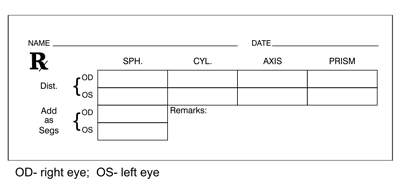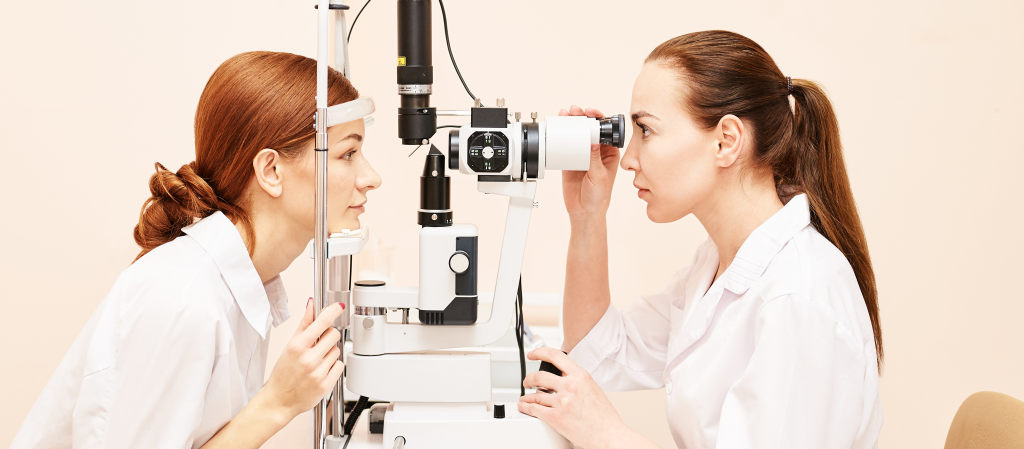-
Summer Savings: Save 20% On LASIK , Find More
*Must mention this promotion and be treated in August of 2024 to qualify. 20% off standard price of Wavelight procedure. Cannot be combined with any other offers.
Reading Your Eyeglass Prescription: How to Crack the Code
Do you feel like you need special code-cracking skills when trying to decipher the information on your eyeglass prescription? Most people understand the basics of 20/20 vision. But it can be mind-boggling to comprehend the details of your eyeglass prescription and how it affects the way your eyeglasses are designed to help you achieve the desired 20/20 vision.

Today, we are breaking down the basics… giving you the key to unlocking this information. Here’s what you need to know as you are reviewing your prescription details:
Eyeglass Prescription Abbreviations
Not only do you need to know what the abbreviations stand for, but you might feel the need for a translation app to understand the meaning of the Latin words that are used. We’ll make it simple by providing explanations of the common abbreviations and terms you will find in the prescription:
- SPH: This abbreviation means “sphere,” which is the amount of lens power required. Diopters are used to measure the sphere.
- D (Diopter): This term is the unit used to indicate the focusing power required for the lens of your eye to see clearly. Numbers are used to represent diopters.
- CYL: When you see CYL, it is referring to the cylinder. This amount is the lens power needed for astigmatism. Instead of being spherical (like SPH), it has no added curvature and uses a unique shape to correct the variances that occur with astigmatism. If you don’t have astigmatism, then nothing will be listed in this column on your prescription.
- Axis: This term is also used for astigmatism prescriptions. A number will be listed from 1 – 180, which is the degree your astigmatism is located. Then, the lens can be oriented to the location to optimize vision.
- + (Plus) Sign: If a + sign is listed in front of the number, then it means you are farsighted. You can see things at a distance, but close objects aren’t clear.
- – (Minus) Sign: When a – sign listed in front of the number, then it is an indication of nearsightedness. You can see things close by, but objects in the distance are blurry.
- ADD: This abbreviation is used when a patient has age-related vision loss that affects the clarity of close objects (presbyopia). If you have difficulty reading or seeing small objects in your hand, then progressive or bifocal lenses can be used to magnify objects when you look down. The ADD number indicates the magnification power needed for your eyes, represented by a plus sign and numbers.

In addition to the terms listed above, abbreviations are also used to indicate the prescription for individual eyes (or both eyes):
- OS (Oculus Sinister): Left eye
- OD (Oculus Dexter): Right eye
- OU: Both eyes
The eye doctor must indicate the unique prescription for each eye because it is common for people to have variations in the clarity of their eyes. One exception is in the bifocal magnifying power for presbyopia, which is typically the same for both eyes.
Uncommon Prescription Abbreviations
In addition to the terms listed above, sometimes there are unique terms on the eyeglass prescription. If a patient has double vision, lazy eye, or other alignment issues, then Prism and Base are used to indicate the prismatic power needed in the lens. Only a small percentage of patients need prism, so most people don’t have this information on their prescriptions.
Prism is listed in either metric units or fractions, indicating the prismatic power required. A Base column is listed to indicate the prism direction based on the thickest edge of the base. Base abbreviations are as follows:
- BU: Base Up
- BD: Base Down
- BI: Base In
- BO: Base Out
Prescription Examples (and What They Mean)
As a general rule of thumb, the further the number is from zero, the more vision correction is required. During the exam, the eye doctor determines the visual acuity of your eyes. Then these prescription numbers are listed in the prescription based on the vision correction needed to bring your eyes back into a normal range.
Let’s break it down a little more, with a few examples to help you see clearly. You might read something like this on your eyeglass prescription:
- OS -1.50 SPH +1.00 add 0.5 p.d. BU
This prescription is for the left eye, and -1.50 means that your nearsightedness is measured at 1 and 1/2 diopters. It’s considered a mild amount of nearsightedness. SPH indicates the adjustment for spherical power, with a prismatic correction of 0.5 Base Up. The prescription will have another similar listing starting with OD for the right eye.
On the other hand, if you have a prescription that is -5.00, then it means that your nearsightedness is more pronounced, so a more powerful lens is used to help you reach 20/20 vision. Also, it is important to note that your prescription only applies to eyeglasses. Contact lenses require a different power due to the placement of the lens on the eye directly.
Other Lens Recommendations
Unique features can be added to eyeglasses, helping to improve your overall comfort and results while wearing the glasses. These optional features are used based on your normal lifestyle and personal needs. Common additions include:
- Anti-Reflective Coating: Beneficial for reducing eye strain, especially when someone works at a computer or spends a lot of time looking at a screen – which is a common occurrence in today’s society. The AR coating reduces the reflections on the front and back surfaces of the lenses, which reduces distractions and allows optimal visual acuity. AR coating can also be added for cosmetic purposes to make the lenses look invisible and draw more attention to the eyes.
- Photochromic Lenses: If you don’t like the inconvenience of carrying both eyeglasses and sunglasses, then photochromic lenses (also known as transition lenses) are the perfect solution. These lenses adapt to the light, giving you clear lenses indoors and tinted lenses outdoors. The shade adjusts automatically when exposed to sunlight.
- Progressive Lenses: When multi-focal lenses are required, the bifocal line can be eliminated by using a progressive design. These lenses look like single vision lenses. But the vision correction naturally fades with multiple prescriptions within the same lens: distant, intermediate, and near. This multi-functional lens makes it possible to see all distances without the abrupt prescription change with a bifocal design.
Find a Trusted Eyecare Provider

If you have questions about your prescription, then the best solution is to talk to an eye care provider in your area. At LasikPlus, we can help you find a trusted eye doctor who can help with prescriptions or other vision correction treatments, such as LASIK. Schedule an appointment or call 1.866.755.2026.
YOU MIGHT ALSO LIKE...
VISION CENTERS NEAR ME
Enter your zip code, city, or a doctor name below to find a vision center.
Find out if LASIK is right for you
Congratulations!
Your vision issues can most likely be corrected with a LASIK procedure. Schedule a free consultation today.
Answer 5 simple questions to see if you are a candidate
What is your age group?
Do you wear...
With corrective lenses, do you have...
Have you ever been told that you have astigmatism?
Have you ever been told that you have dry eyes?
Request an Information Kit
Learn about your surgeon, the latest advanced technology, procedures, options and benefits, financing options, and what to expect from your LASIKPlus experience.









